深度分析赢利冠军《Rage of Bahamut》游戏机制
作者:Simon Newstead
想象一下,一款占据美国iOS应用收益排行榜宝座长达三个月的游戏应该是怎么样的。跟我差不多,你可能想到的是精美的图象画面、简洁灵活的UI和悦耳动听的音乐?
那你就错了。
事实上,当你第一次玩日本开发商Cygames(由DeNA/ngmoco发行)制作的《Rage of Bahamut》(以下简称ROB)时,你可能会以为自己不小心下载了另一款游戏。
视觉画面?日式漫画风,算不上出类拔萃。
UI?一张带文字、链接、按钮和时常滚出广告页面的网页。
声音?这游戏没声音。真的。
但以上三点都没有拖它的后腿。
ROB是内涵(游戏机制)压倒外表(外部设计)的光荣胜利。
百万美元证明了深度才是王道(游戏设计师们可以感到欣慰了)。
究竟是什么导致它成为这么一匹赢利黑马?以下是我分析得出的几个关键点。
适合手机玩家的核心游戏循环
我们从基本玩法说起。
ROB是一款卡片收集游戏(CCG),其核心游戏循环非常严密:
1、玩家使用几套具有各种属性的卡片来做任务和战斗(PVE和PVP)。
2、玩家得到资源:软钱(卢比)、道具、圣宝、卡片和经验。
3、接着你可以升级、得到新卡片和更新你的卡片。
4、有了更多新卡片后,你可以完成更困难的任务,与更强大的敌人战斗,得到更好的奖励。
5、重复。
这是很容易理解的概念,轻轻松松就让玩家落入刷进度的循环圈中。
作为一款强调数值的游戏(并没有真正的战斗或即时技能),它吸引玩家深入挖掘的属性有很多。
正是这种本质,使这款游戏非常适合用手机玩。
这款游戏:
1、上手容易,UI设计很适合小屏幕的手机。
2、有竖直方向,所以容易单手操作。
3、游戏回合短——活动不费时间(每一场战斗不超过30秒)。
4、充分利用琐碎的时间(比如换车、搭电梯时)。
以上是构成我们接下来要谈的赢利元素的基础。
ROB还具有大量提高玩家留存率和强化病毒性传播的特点,不过不在本文的讨论范围。
IAP消除时间限制
好吧,与所有现代社交游戏相同,ROB限制玩家每一次的游戏时间,但通过购买游戏内的道具可消除这个限制:
这是通过两个主要机制来实现的——耐力(用于PVE任务的进程)和战斗力(用于PVE的BOSS战和PVP)。
所有活动都会消耗这两种东西,但会按每分钟1点的速度恢复。
通过硬钱(怒气勋章)购买消耗品“治愈之水”和“神圣粉末“可以分别恢复这两种东西。
这两种基本机制刺激玩家花钱减少等待时间,同时拖延不花钱玩家的游戏进度。
抽卡和收集机制
接着我们来说说抽卡机制。
《ROB》中具有若干类型、数百张卡片,各种卡片都有不同的属性、成长度和进化状态。
活跃玩家希望得到更好的卡片,而途径就是玩法、交易或购买卡包——核心赢利机制。
玩家可以点击UI顶部那个显眼的图标购买卡包。
一个卡包(有若干种)包含一定数量的随机卡片,总是有很小的概率得到稀有(更强大的)道具。
例如,一般稀有度的卡片如水晶女王(如上图)及以上稀有度的卡片有很小的概率会落在传奇卡包里。游戏中包含至少8个级别的稀有度(包括一般级)。
即使得到不好的卡片,也不是没有用的,至少可以拿来作为升级其他卡片的素材,从而避免编辑出不好的卡片组合(详见下文)。
游戏坚实的赌博机制使玩家相信,下一个卡包有可能会出极品。即使购买卡包要花大量真钱也再所不惜。
另一个相关的机制是游戏中的收集,玩家收集到完整的系列将得到额外奖励。
举个例子:
在任务和PVP中(你可以在对手的道具中选择特定的目标道具),玩家有可能从圣宝组合中得到一样道具,当完成时,你就会得到完成奖励。事件中也有这种设定,即当玩家完成一系列事件时,游戏会解锁额外道具。
收集卡片也是非常受欢迎的游戏机制,所以就有以下面这个话题……
深刻的更新系统
ROB包含一系列与卡片相关的设定,作用是鼓励玩家寻找和消耗卡片以强化其他卡片。
通过卡片升级系统,玩家会花更多时间和金钱在游戏上,因为想让自己的卡片“好上加好”。
第一种卡片升级是强化,即牺牲其他卡片(作为素材)来升级卡片阶数和战斗属性(进攻和防御)。
第二种卡片升级是进化,即将两张相同类型的卡片融合成一张更强大的卡片——通常有4个进化阶数,阶数越高就越稀有。阶数4的卡片是用相同角色的不同图像版本表示(如下图)。
就像RPG中的技艺配方系统,玩家可以通过各种有趣的组合方式,得到不同的结果。
这个系统还根据“收益递减法则”运作。
卡片有最大属性值,越接近最大值,消耗的资源量就越大。
比如,一张最大值成长度达到98%的卡片,为了增加2%最终达到100%就需要15张强化素材卡。
这最适合完美主义者了。
就好像世界级运动员,哪怕接近世界记录百分之一秒, 需要经历无数次竞技和训练,还要使用更高级的装备。
对于这款游戏的目标受众,这绝对是强大的吸引力,再结合PVP的竞技属性,游戏的赢利能力就更强了。
合适的教程
除了粗俗的语句和无尽的点击,游戏的教程意外地很讨人欢喜;更重要的是,通过向导NPC的模拟,玩家可以提前了解关键的赢利机制—-抽卡、卡包、卡片升级和PVP等。
另外,教程一开始的选项就使用玩家个人信息,使玩家产生一种亲切感。我得说,这是玩家对游戏的第一次情绪投入,一旦玩家产生这种情绪,也就更可能掏钱了。
PVP——挑战、反挑战和竞技精神
与其他位居收益前列的游戏一样(游戏邦注:如《Kingdoms of Camelot》和《Backyard Monsters》),这款游戏的PVP系统非常有深度,这也是使《ROB》成功的重要原因。
玩家可以发起对战(通过各种技能/效果调整你的攻战力与对手的防战力之比),胜利方得到道具、金钱(按失败方药水量的百分比)和圣宝。
当然,游戏有保护机制,高等级玩家欺负低等级玩家,即高等级玩家挑战比自己等级低很多的玩家时,可能会遭到天谴,从而自动输掉战斗。
总之,PVP鼓励玩家花钱增加他们的攻战力和防战力。
PVP也可能产生负面影响——对于别人强加的损失,人会产生一种强烈的反应(温习一下进化心理学理论),其程度甚至比获得某物时的积极情绪更强。竞争和进化的背景下,人的本性甚至会刺激其在游戏中投入更多金钱。
利用玩家害怕损失的心理,游戏还允许玩家给自己的圣宝(金钱有其他保护方式)购买保险(反挑战)。玩家可以购买一个魔法阵放在想要保护的圣宝上。当它被其他玩家攻击时,就会自动取得胜利。
除了直接的PVP战斗系统,等级超过10的玩家还有元游戏可玩(更高深的赢利系统开始起作用了)。战绩排行榜、编辑在挑战和防御PVP中得到的属性。这可用于决定这段时间内的最佳玩家,然后根据他们的排名奖励其金钱、宝石,这些奖励可以用来兑换道具和更强大的卡片。
战绩排行榜会定时重置,以鼓励玩家升级和花钱。
骑士团和骑士团PVP
继续PVP主题,ROB有一点做得特别出色,即公会的执行,或者按游戏中的术语称之为“骑士团”。
只有一定等级的玩家才能加入骑士团,玩家加入骑士团后形成自己的组织,可以在团队中竞争领导权、职位、等级等。
骑士团鼓励通过捐款参与团队建设,骑士团团长还可以建造特殊的建筑给所有成员分配额外好处。
例如,团长建造的教堂可以增加所有神域卡片的5%的进攻力和防御力,但要消耗300万卢比。
与玩家和他们的卡片一样,骑士团也可以通过成员捐款得到升级,捐款可以扩充骑士团的人数上限,这在骑士团PVP中是非常有用的。
骑士团PVP是通过“圣战系统”实现的,团长在某个时间段内宣战,并自动匹配其他团长(我不知道那个算法),触发限时事件,即骑士团成员彼此对战,最后产生排名(由公会PVP的特殊属性排列,即圣战点),根据最终排名奖励玩家卡片。
ROB中的骑士团结构和骑士团PVP系统对赢利的促进体现在如下几点中:
1、形成玩家扶持骑士团、骑士团帮助玩家的循环圈。
2、骑士团事件和结构使玩家有了花钱帮助团队表现的理由。
3、骑士团作为论坛交流工具,便于开展如交易等经济活动。
4、骑士团团长的作用会鼓励成员多多花钱。
5、鼓励提携精神,即老成员帮助其他新成员。
6、形成牢固的社交纽带(同甘共苦),从而提高玩家留存率。
注意:除了骑士团系统,还有所谓的“战友”这样的个人团体系统(每个人都可以有一个帮!)。我不打算在本文中讨论这一点,因为我认为它只是间接促进赢利,与赢利没有直接关系,尽管在这种机制下,“头儿”卡片也会增加一定的攻击力;即以互惠的方式帮助彼此升级。
事件
事件是关键—-保证游戏新鲜感和鼓励玩家返回游戏、引入新目标。
在最近事件中,玩家使用魔法月泪阻止邪恶力量。
除了骑士团PVP事件(圣战),还有PVE事件,鼓励团队合作,鼓励购买针对事件的卡片。
这个循环很浅显,但就是很有效,特别是遇上共享事件(如果间接系统的收费可以更合理的话,应该会很有趣)。
事件还与一般的刷任务机制(即任务系统)相结合,但通常具有额外的随机效果,也就是延长玩家的参与时间。在金币转蛋机制中也有这类事件,即随机时间发放随机奖励。
尽管需要执行和管理的工作量很大(游戏邦注:玩家们对最近事件的技术问题颇有不满),但赢利机制对忠实的付费玩家的影响似乎非常强。
道具交易和经济
ROB的最后一个特点是强大的交易系统。它构造了一个简单但是高效的经济系统。玩家可以在好友之间自由交易货币、卡片和道具。
虽然玩家事件是通过升级和随机掉落来“产生价值”的,但价值可以在玩家之间转移。从心理上讲,这意味着在升级、任务和收集中的投入是“值得的”。
除了拓展游戏玩法,交易还给游戏玩法增加了新维度,也就是允许玩家参与互相交易,从直接出售和购买自己想要的道具中得到好处。
理论上说,这种交易似乎会抑制高端付费玩家与游戏之间的消费活动,因为玩家可以选择跟另一名玩家交易(另一名玩家事实上可能没有付费),而不是直接与游戏交易,这样就将免费的时间转化成付费的价值。但事实上,这种交易系统与随机掉落和游戏的升级特点结合得非常好,基本上能鼓励玩家在游戏中积极消费和收集。
总结
我认为ROB的成功归咎于卓越的游戏设计和深刻的系统,二者或直接或间接地带动了游戏的赢利。
简而言之,这款游戏采用了多种刺激玩家消费的策略。ROB的赢利策略不仅对高端付费玩家非常有效,并且执行方式又相当温和而有趣。(本文为游戏邦/gamerboom.com编译,拒绝任何不保留版权的转载,如需转载请联系:游戏邦)
Analysing a Top Grossing Game: Rage of Bahamut
by Simon Newstead
Image for a minute, one of the U.S.’s Top Grossing iOS apps.
A freemium game that has stayed top of the charts for the last three months.
Like me, you might imagine a title with gorgeous HD graphics, slick UI and a lush soundtrack?
You’d be mistaken.
In fact, the first time you play Rage of Bahamut by Japanese developer Cygames (published by DeNA/ngmoco), you might think you’ve downloaded another app by accident.
The visuals? Mangalicious, but low def only.
The UI? A web port with text, links, buttons and banners on often long scrolling pages.
Audio? This game doesn’t have any. Really.
But that doesn’t hold it back.
Rage of Bahamut (RoB) is a triumph of game mechanics over glamour.
It’s million dollar proof that depth counts (that should make us game designers happy ![]()
Up at the top of the ranks since launch
Here’s my attempt on breaking down some of the key elements that make it such a monetization monster.
Mobile-Friendly Core Game Loop
First the bread and butter.
RoB is a collectible card game (CCG) with a very solid core game loop:
Quest and battle (pve and pvp) using sets of cards, which have various attributes.
This gives you resources: soft currency (rupies), items, treasures, cards and XP.
In turn these give you the ability to increase your level, acquire and upgrade cards.
Which lets you quest and battle vs more difficult opponents and get better rewards.
Repeat.
It’s a simple to grasp concept that let’s players get right onto an addictive levelling grind in the pursuit of making progress.
Being a numbers heavy game (no actual combat or real time skill involved), there is plenty of depth for stats obsessed gamers to dive into.
By it’s nature it fits well for mobile gameplay.
The game:
is easy to grasp and UI works well on a small phone screen
has a vertical orientation makes it easy to play with one hand
can be played in small snippets – actions don’t take long (eg battle in <30 secs)
can be resumed with minimal real time elements (eg- change trains, go in a lift)
It’s a foundation that sets it up solidly for all the monetization* elements we’ll go into next.
* RoB also has a bunch of well executed retention and viral features (can I interest you in my referral code?) but that’s out of scope for this post.
IAP removed time restrictions
Ok, like all modern social games, RoB restricts how long you can play in a session, a limit that can be removed via IAP:
This is implemented through two main mechanisms – Stamina (used for progressing in pve quests) and Attack Power (used for pve boss battles and in pvp).
Both are consumed through actions, and regenerate at a rate of 1 per minute.
Both can also be refilled through hard currency (rage medal) acquired consumables: “cure water” and “holy power” respectively.
This basic mechanism motivates players to spend to reduce waiting times, and helps pace the game for free users.
Gacha and collection mechanics
Next, the gacha.
There are several types and many hundreds of cards in RoB, each with different attributes and maturation and evolution states.
All active players have a drive to gain better cards be it through gameplay, trading or card pack purchas – a key monetization driver.
Players can purchase card packs in the prominent position on the right of the UI header bar:
A card pack (there are several kinds) contains a set number of random cards, and there is always the small chance to get rarer (more powerful) items.
For example, there is a small chance that an SS Rare card like the Crystal Queen above may drop in a beginner legend card pack. There are at least 8 levels of rarity in the game (including normal).
And even if poor cards are received, they can at least be sacrificed to help upgrade other cards, reducing the psychological sting of drawing a bad set (more on that later).
All up it’s a solid casino mechanic that plays on the notion that you might well “strike it rich” in your next Card Pack. And it doesn’t hurt that Card Packs cost quite a lot of real money.
On a related note there are also collection drivers within the game, with bonuses awarded in case of a set completion.
One example -
In questing and pvp (you can target specific items from opponents) there is the chance to obtain an item from one of the treasure sets, which when complete give you a completion reward. This also carries over to events, where set completion unlocks bonus items.
Collecting of cards is also popular, as a result of the next topic…
Deep upgrading system
RoB includes a couple of systems, commonly used in conjunction that encourage you to source and consume cards to help make other cards incrementally stronger.
This has the net effect of encouraging more gameplay and monetization sinked through the card upgrade system, that plays into the desire to make good cards “that much better”.
The first- enhancing is a way to upgrade a cards level and battle stats (attack and defence) by sacrificing other cards, called feeders.
The second- evolving is a way to combine two cards of the same type to a more powerful version of the card – there are normally 4 evolution levels, and at the final level the cards rarity also goes up one level. The 4 levels are represented visually by different graphic versions of the same character, as in this Archangel example:
Like an an RPGs recipe and crafting system, these systems can be used in a variety of interesting combinations, yielding different results.
The systems also operate on a “law of diminishing returns”.
Cards have maximum rating, and increases towards a maximum require a greatly increasing amount of resources.
A maximum card evolution with only a few enhancements might deliver close to 98% of maximum, but to squeeze the last couple of percent up to 100% could take an enhancement investment of 15 (ie all cards enhanced in the evolution process).
Perfect for perfectionists ![]()
An analogy might be world class athletes, competing and training more and using increasingly advanced technology to shave off ever decreasing milliseconds off world records.
This makes it an awesome sink especially for its target audience, and combined with PvP participants competitive natures a strong monetization driver.
Well executed tutorial
Despite cheesy lines and endless tapping, the tutorial is strangely endearing, and more importantly introduces the player early to the key monetization systems – gacha, card packs, card upgrade and PvP, via a simulation with the guide npc.
Also subtle, the realm choice at the start of the tutorial uses your personal preference to drive the first sense of alliance and community. I’d say it represents the first emotional investment in the game, and players are generally more receptive to pay if they are hooked in emotionally.
PvP – revenge, proactive revenge and competitive spirit
Like other top grossing games (think Kingdoms of Camelot or Backyard Monsters), PvP goes deep and is a key part of RoB’s success.
Players can battle each other (your attack strength vs their defence strength modulated by various skills/effects) and by winning, gain among other things, currency (a percent of the losers liquid amount up to a certain value) and treasure.
Whilst there is some protection mechanisms so that lower level players don’t get beaten down by much higher level players, beyond that you have the chance to attack and be attacked, with impact.
This encourages players to spend to money to increase their attack and defence scores.
PvP can also get personal – there is a strong human reaction (dust off the evolutionary psychology theory) to a loss inflicted by another, even more than a positive emotional impact gaining something. Rivalry and in the evolutionary context, putting a wayward tribe member back in place I believe motivates even more monetary investment.
Feeding from that fear of loss, the game also lets you buy insurance (proactive revenge) for your treasure items (currency can be indirectly protected in other ways). The game lets you buy a magic circle to place on your treasure items. A magic circle fires once when that item is targeted by another player, automatically inflicting a loss on them.
Beyond the direct PvP battle system there is also a meta game available for players over level 10 (where some of the deeper monetization systems kick in), with a leaderboard of battle rankings, compiled using another attribute gained in proactive and defensive PvP. This is used to determine the best players during that time period, and based on their placement they are granted another currency, gems, that can be then redeemed for items and even more powerful cards.
Battle leaderboards are reset regularly, encouraging ongoing level of competition and investment in the game.
Guilds and guild PvP
Continuing on the PvP theme, one area RoB has done particularly well is their implementations of guilds, or in their terminology, “Orders”.
Only available to more established players (level requirement), orders let players join and then ultimately form their own groups, complete with leadership, roles and hierarchy.
Orders enable encourage investment in a group via a donations mechanism, and the leadership can also construct speciality walls and buildings that confer attribute bonuses to all members.
For example, a church constructed by an order can boost all God realm cards attack and defence by 5%, for a cost of 3 million Rupies.
Like players and their cards, orders themselves can be leveled up through group donations which has the impact of increasing the maximum number of members up beyond 30, which is useful in guild PvP.
Guild PvP is implemented through a “Holy War” system, whereby an order declares war during a set time period, and is matched automatically with another order (I didn’t figure out that algorithm), triggering a time limited event where order members battle each other, with resulting rankings (tabulated by a guild PvP specific attribute, Holy War Points) that ultimately translate into more cards.
The guild structure and guild PvP system in RoB have several benefits to monetization:
A loop of helping a guild which helps the player which helps the guild etc
Guild events and structures give a reason to spend to help the team performance
Guilds communication tools eg forums facilitate economic activities like trading
Guild leadership roles encourage more investment by those members
Encourages patronage relationships where senior members desire to help others
And of course a strong social bond (shared struggle, shared rewards) that encourages higher ongoing retention
Note – In addition to the order guild system, there is also a personal group system (everyone gets a guild!) called Fellows. I won’t go into that in this post as I understand it as more of a viral/sticky tool rather than directly monetization related, but indirectly helps monetization through mechanics where fellows leader cards can assist in certain attacks. ie- we upgrade and can help each other in a reciprocal manner.
Ongoing events
Events are key – keeping the game evergreen and encourage returning play and introducing new goals to drive towards.
In a recent event, players were encouraged to stop evil entities from using magic moon tears
In addition to guild PvP events (Holy Wars) there are also PvE events that encourage team work, and encourage purchase towards event specific cards which help in the specific event they appear in.
The loop is obvious and direct but appears to works, especially when caught up in the thrill of the shared event (would be interesting to see if an indirect system would have fared better)
Events also tie in with normal grind mechanics (eg quest system) but with typically additional random effects that let players participate for longer. This also ties in with a gacha mechanic whereby random rewards are assigned at random times.
Whilst a lot of work to implement and manage (there was a community uproar over technical issues in a recent event) the monetization impact particularly to dedicated paying users looks strong.
Item trading and economy
Last but not least RoB features a robust trading system and with it a simple but effective economy with de-facto item exchange rates (eg- to consumable items). Players can freely trade currency, cards and items with their friends.
As player activity “generates value” through upgrades and random drops through extended gameplay, that value can be transferred between players. Psychologically this can mean investment in upgrades, grinding and collection is “worth it”.
This also adds another dimension to the gameplay, allowing players to participate in a (often as satisfying) meta game of trading, profiting from sales as well as purchasing desired items directly.
Whilst in theory trading might be seen to reduce high end paying user monetization as it gives an option to purchase from another player (who in theory may have been farming for free) rather than directly from the game, converting free time into paid value, in reality it plays well with the random drop and upgrade nature of the game, encouraging more collection and investment in the game in general.
Summary
I believe Rage of Bahamut succeeds because of its excellent game design and deep systems that directly and indirectly drive monetization.
Put simply there are many different reasons and ways to spend your money.
It’s a great match to a high paying demographic and is implemented in a way that is mobile friendly and of course, fun.(source:iteratingfun)

























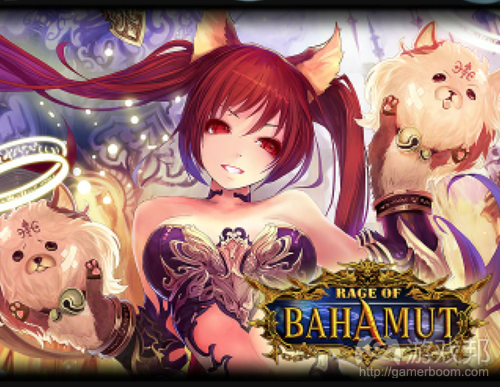
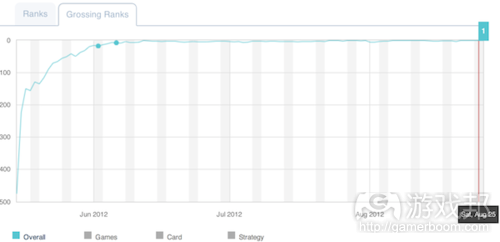
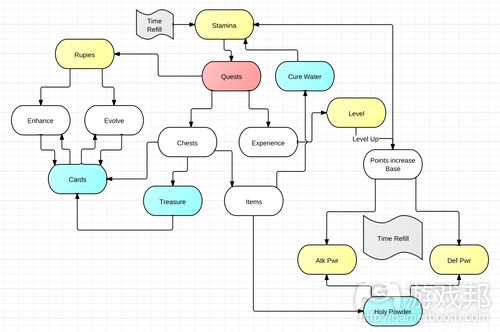
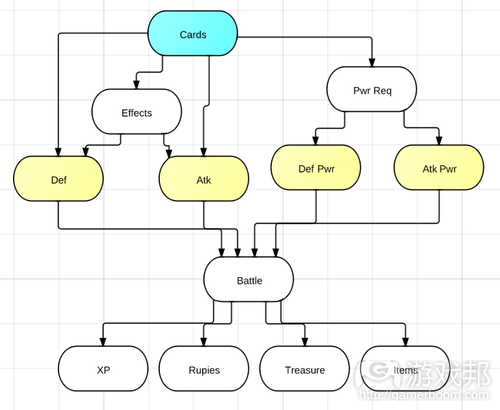
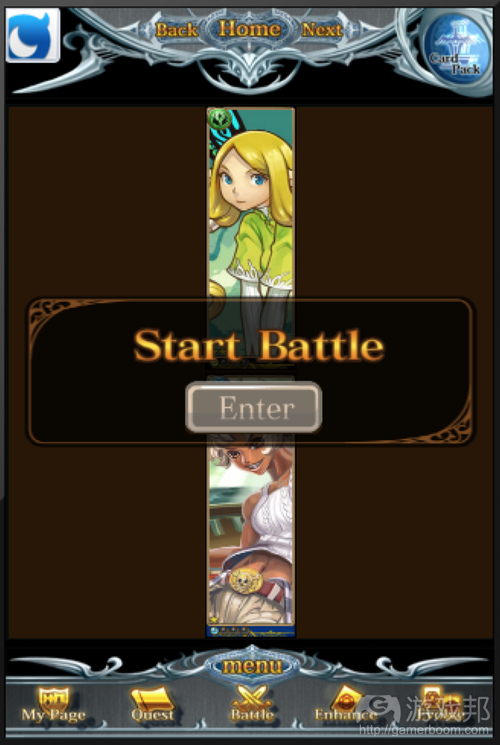
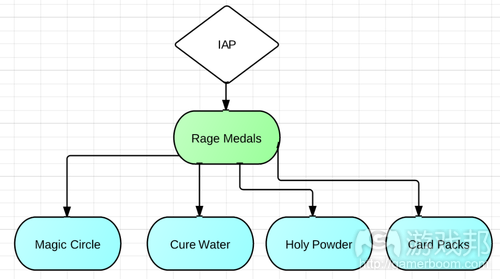


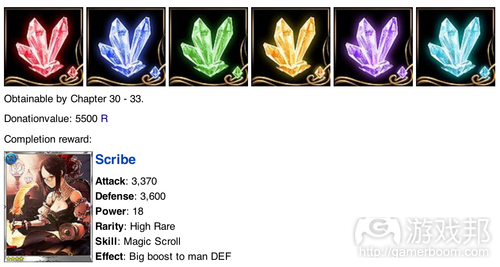


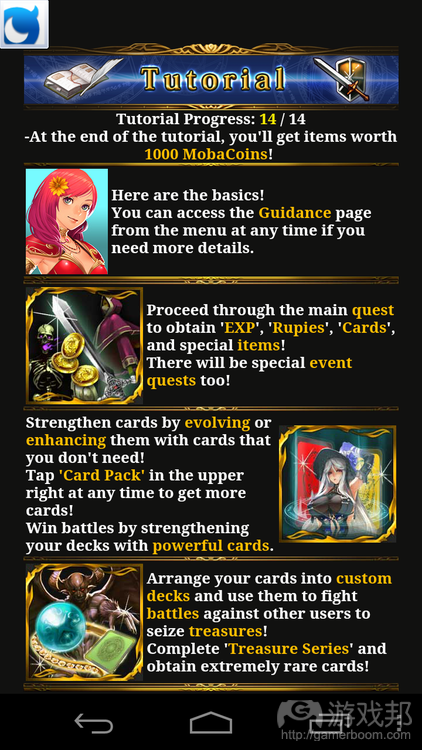



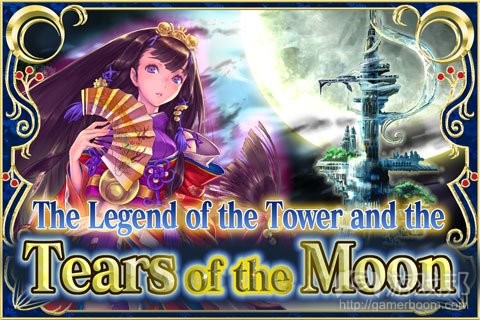















 闽公网安备35020302001549号
闽公网安备35020302001549号